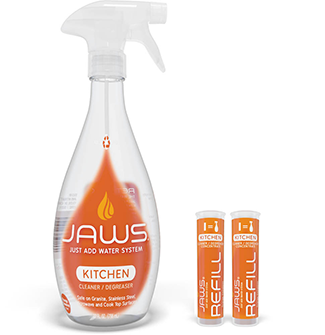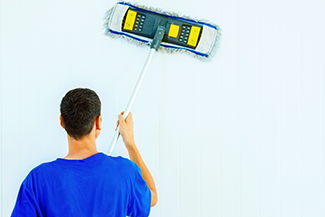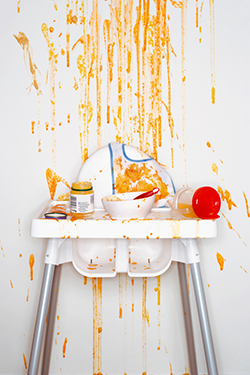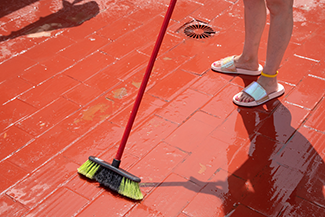Keep Painted Surfaces In Pristine Condition With Regular Cleaning
 22 February 2022
22 February 2022 

Extend The Life Of Your Wall Paint With Regular Cleaning
Whether your walls were painted recently or a while ago, they must be part of your cleaning regimen. Regularly cleaned walls will keep the paint looking its best and extend the life of the paint.
Before we dive into the cleaning details, never mix ammonia with bleach. The fumes are toxic, and the mixture will destroy the paintwork. Avoid using bleach or coarse scrubbing brushes. Open the windows during and after cleaning for ventilation.
General Interior Paint Cleaning
Wall paint is easy to damage and streak. Always start with your mildest cleansing option, and use something stronger if you need to, especially for eggshell and satin walls.

JAWS cleaners, available in our e-Store, can be used on surfaces not harmed by water. For painted surfaces, JAWS recommends:
- JAWS Kitchen Cleaner
- JAWS Multi-Purpose Cleaner
- JAWS Glass Cleaner
These JAWS cleaners can be used on walls and painted furniture. Note: Do not use their Foaming Bathroom Cleaner for painted surfaces because it is acidic.
Always test your cleaning solution and technique in an inconspicuous area to ensure that it does not damage the paint film. Follow the label's instructions to ensure the cleaner won't harm the paint's finish.
If the paint on the walls is new, Sherwin-Williams recommends waiting at least two weeks after painting before using any water or cleaner on your walls.
Typically, it’s best to use a soft cloth or sponge with mild, soapy water. Thoroughly wring out the cloth or sponge. Too much water can ruin your paint finish. Too much cleaner can leave streaks. Wipe by applying gentle pressure in a circular motion. Rinse with a clean, damp cloth afterward to remove any leftover cleaner.
Don't use a paint roller to clean the walls. It is not effective, and you will get streaks.
This video by Sherwin-Williams shows how to clean painted walls.
Cleaning Materials Checklist
- Vacuum cleaner with dust brush attachment
- Tack cloth/Cheesecloth
- Wash bucket
- Mild household cleaner
- Grease-cutting dishwashing soap
- Baking soda
- Cloth rags
- Touch-up paint
- Plastic mixing container
- Mini paint roller and roller cover
- 2-inch or 2½-inch angled bristle brush
Dusting

Regardless of paint type or sheen, regular dusting is in order. Before you do any washing, run the dust brush attachment on the vacuum over ceilings and walls.
Joe Campbell, Arizona Painting Company , a Rosie-Certified Partner, suggests using a duster or microfiber cloth to remove dust and debris that has dulled the paint's appearance. Dusting will make cleaning more effective.
If you encounter mold, don't mess with it. Hire a professional mold remediator to remove it.
Spots, Smudges & Stains
Using a paste of baking soda and water, gently rub the solution over the problem area. Rinse with a sponge and dry with a soft cloth. For grease splatters on kitchen walls, combine one to two drops of dish detergent with one quart of warm water. JAWS Kitchen Cleaner is another option.
Spills & Splatters

Clean up spills and splatters right away. The longer they remain on the surface, the more they can seep into the paint, making them difficult to remove.
Scrape off clumps of food or sticky substances. Blot the area with paper towels. Don’t wipe. The mess will spread. Apply a squirt of dish soap to a warm, damp, slightly scrubby sponge. Gently scrub the area. Pat dry with a soft cloth.
Cleaning by Finish
Avoid using harsh scrubby sponges or rough materials. Use a soft cellulose sponge and cloth to avoid scratching the surface.
Do not allow the wall to dry naturally. You will end up with water stains. Use a soft, lint-free cloth to dry each section as you finish cleaning.
Eggshell, Satin & Flat Finishes
Because these finishes can be easily damaged, do not use chemicals or degreasers.
- Option 1: mix a few drops of gentle, dye-free dish detergent in a half-gallon bucket of water.
- Option 2: mix two to three tablespoons of white vinegar with one gallon of warm water.
Gloss & Semi-Gloss Finishes
Gloss and semi-gloss paints are generally used in the kitchen and can withstand a degreaser.
- Option 1: spray a cloth with JAWS Kitchen Cleaner and wipe the surface.
- Option 2: combine one teaspoon of dish detergent, one-quarter teaspoon white vinegar, and one quart of warm water. Let the solution sit for 10 minutes before cleaning.
Cleaning Other Painted Materials
Wood Furniture
Use a feather duster or microfiber cloth to remove dust, cobwebs, and dust bunnies. Carefully vacuum with the crevice tool or upholstery brush attachment. Don't use the vacuum if the paint is likely to chip or flake. Gently wipe corners and crevices with dry cotton swabs.
Combine one tablespoon white vinegar with two cups of warm water and a squirt of liquid dish soap. Dip a white, lint-free cloth or sponge into the solution, wring it out, and wipe down the surface. Remove any soapy residue. Pat dry with a white lint-free cloth.
Metal Furniture
Remove loose paint, rust, or mold with a stiff wire brush. Then sand with fine-grit sandpaper edges until smooth.
Prepare a solution of one quarter cup mild dishwashing liquid and one gallon of warm water. Dampen a sponge or a soft-bristle brush to scrub the furniture's surface thoroughly. Rinse and pat dry with a lint-free cloth.
Wood Flooring
Sweep the floor with a soft-bristle broom. Follow up with a dust mop or a soft, damp sponge at least once a week to prevent heavy dirt buildup.
Remove stains with a mixture of equal parts white vinegar and water. Saturate a paper towel with the mixture and place it over the stained area for about 10 minutes. Gently rub the stain away. For tough stains, apply a thick paste of baking soda and water. Gently work the paste, let dry, and wipe away.

Concrete Flooring
Sweep the floor with a soft-bristle broom. Follow up with a dust-catching cloth and vacuum the surface.
Concrete floor cleaner is available at most home improvement stores. However, not all are formulated for painted floors. Avoid cleaners that have highly acidic ingredients or bleach and ammonia.
Make your own cleaner with a mixture of Castile soap and hot water. Soak a mop in the solution and wring it out until it is damp. Run the mop over the painted concrete floor. Don’t let water pool on the surface. Rinse with clear, clean water and allow to thoroughly dry, particularly in the corners.
###
Podcast
We share tips on keeping recently painted areas clean and some of the trends found at the Kitchen And Bath International Show. The mystery sound coming from a newly built home is SOLVED; the homebuilder explains what it is and how they repaired it. Plus caller questions on a backyard fountain pump problem and what it takes for a drywall finish level 5.
Photo Credit
- Shutterstock
Related Content
- DIY FAQ: Reviving Repairing Interior Paint
- DIY FAQ: How Long Will A Paint Brush Last?
- DIY FAQ: Wear, Tear & Care Of Outdoor Surfaces
Print this page
recent post
- Duck, Duck, Duct! How Often Should Ductwork Be Cleaned?
- Vinyl vs. Fiberglass Windows: Which Is The Better Choice Of Replacement Window?
- We May Be The Grand Canyon State, But The Rocky Mountains Are Important For Arizona
- Welcome to Arizona! Things A Newbie to Arizona Should Know
- The Pros & Cons of Buying A Flipped House
- Getting In On The Ground Floor
- Why It’s More Critical Than Ever To Get Your AC Serviced Before Summer
- The Reality of Remodeling
- What To Look For When Comparing Your Roofing Quotes
- What To Expect When Buying New Windows & Doors
